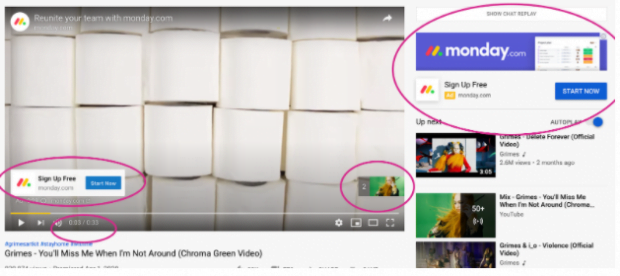Brands advertise on YouTube because it’s the world’s second most popular website, drawing 2 billion logged-in visitors a month.
If you’re deciding how to allocate your video ad budget, YouTube has the vast reach and powerful targeting capabilities that make it an undeniably valuable platform across the customer journey.
But let’s be upfront: YouTube ads aren’t the most intuitive part of your social media advertising strategy. Rest assured that taking a bit of extra time to learn the fundamentals now is going to pay off in your ROI later.
In this article we’ll take a look at your ad format options, run through how to set up a video ad campaign, list up-to-date ad specs, and leave you inspired with best practices from proven performers.
Bonus: Download a free guide that reveals the exact steps one creator took to gain more than 23,000,000 views on YouTube with no budget and no expensive gear.
Types of YouTube ads
To start, let’s take a look at the main types of ads on YouTube, both video and otherwise:
- Skippable in-stream ads
- Non-skippable in-stream ads (including bumper ads)
- Video discovery ads (formerly known as in-display ads)
- Non-video ads (i.e., overlays and banners)
If you’ve already been spending time fine-tuning your YouTube marketing strategy, you’re probably familiar with most of these formats, by virtue of having seen them in action. But let’s walk through and take a gander at the details.
1. Skippable in-stream video ads
These ads play before or during a video (a.k.a. “pre-roll” or “mid-roll”). Their defining feature is that viewers can choose to skip them after the first 5 seconds.
As an advertiser, you only pay when viewers choose to keep watching past those first 5 seconds. Your ad must be at least 12 seconds long (though somewhere under 3 minutes is recommended).
You pay when a person has watched the first 30 seconds, or the whole thing, or if they interact with your ad by clicking: whichever comes first.
Sidebar: You’ll see the term “TrueView” pop up a lot. TrueView is YouTube’s pet name for the payment type where you only pay for an ad impression when a user chooses to watch it. (The other type of TrueView video ad is the discovery ad type, and we’ll give more details on that below.)
For example, take a look at how B2B company Monday.com uses skippable in-stream ads for lead generation. On the right, there’s a 5-second countdown to when a viewer can skip the ad. On the left, you can see plainly how long the ad is (0:33 seconds, in this case.)
Meanwhile, their sign-up CTA shows up in both a companion banner in the top right of the display, and a video overlay in the bottom left. (Note that even if a viewer skips the video, the companion banner remains.)
Likewise, B2C online education brand MasterClass uses skippable in-stream pre-roll ads to promote their memberships. However, theirs run long: this one is nearly 2 minutes.
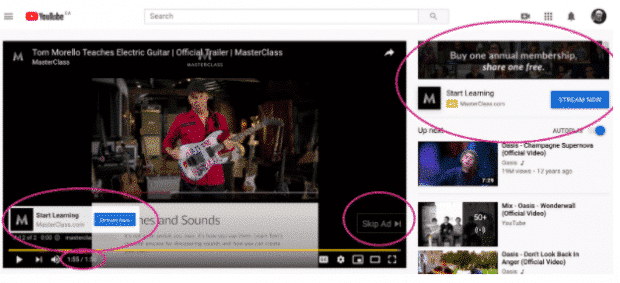
2. Non-skippable in-stream video ads
Because 76% of people report that they automatically skip ads, some advertisers choose to run pre-roll or mid-roll ads that don’t have a skip button at all.
When should you do this? When you’re aiming for a wide lift in brand awareness, and you’re confident that your creative is strong enough to hold your audience’s attention for the full 15 seconds.*
Note that with non-skippable ads, advertisers pay per impression, at CPM (i.e., per 1,000 views).
*Or up to 20 seconds if you’re in India, Malaysia, Mexico, Singapore or EMEA in general.
Bumper ads
At 6 seconds long, bumper ads are a snappy subspecies of non-skippable in-stream ad. They’re identical in that you pay for impressions, they show up as pre-, mid- or post-roll, and they’re generally best used for reach and awareness campaigns.
3. Discovery ads
Whereas in-stream ads function something like a traditional TV commercial, discovery ads are more akin to the ads you see on Google’s search results page. (This makes sense when we remember that YouTube is as much a search engine as a social platform.)
Discovery ads show up alongside organic search results. So if your video looks more relevant than the organic results, people can choose to watch it, instead.
Discovery ads include three lines of text along with a thumbnail. When interested people click on the ad, they’re sent through to your video page or YouTube channel.
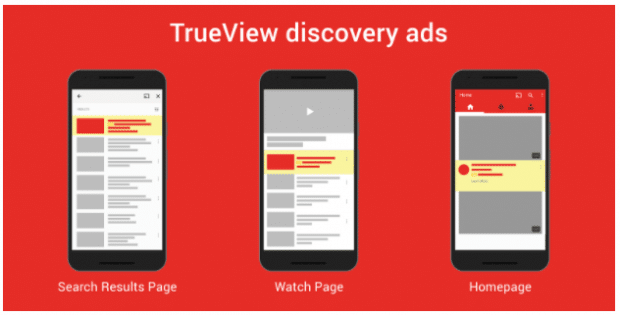
Source: ThinkwithGoogle
Sidebar: Discovery ads are also a type of TrueView ad, because people must actively choose to watch them.
For example, Home Depot Canada has a series of 30-second discovery ads that surface when users type in relevant search terms:
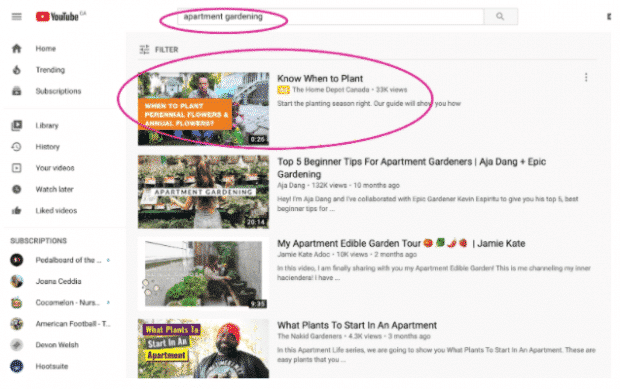
4. Non-video ads
For advertisers without a budget for video, YouTube offers non-video ads.
- Display ads: appear on the right-hand sidebar, and include an image and text, alongside a CTA with a link to your website.
- In-video overlay ads: appear floating on top of video content from monetized YouTube channels.
In an ideal world, both of these ad types appear in conjunction with related content. Of course, that’s not always the case.
For example, this osteopath’s helpful shoulder exercise video probably falls generally under “health,” and perhaps so do these ads for herbal remedies and MRIs. Of course, the chances of a viewer being interested in all three are slim. This is a great argument for being picky about your audience targeting—which we’ll cover in the next section.
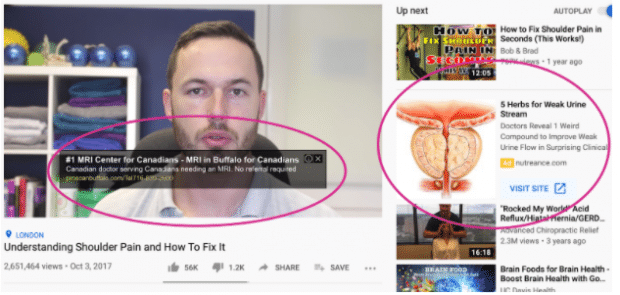
How to advertise on YouTube
Here’s where we get into the nitty gritty. First, your video ad will live on YouTube, so start by uploading the video file to your YouTube channel. Make sure the video is public—or, if you don’t want it popping up in your channel, you can make it unlisted.
1. Create your campaign
Sign in to your Google Ads account and select New Campaign.
a) Choose your campaign goal, based on your brand’s marketing objectives:
- Sales
- Leads
- Website traffic
- Product and brand consideration
- Brand awareness and reach
- Or: create a campaign without a goal’s guidance
b) Select your campaign type. These include all forms of Google ads (including search results, text, shopping) so make sure you select Video or, in some cases, Discovery campaigns in order to show your video to audiences on YouTube.
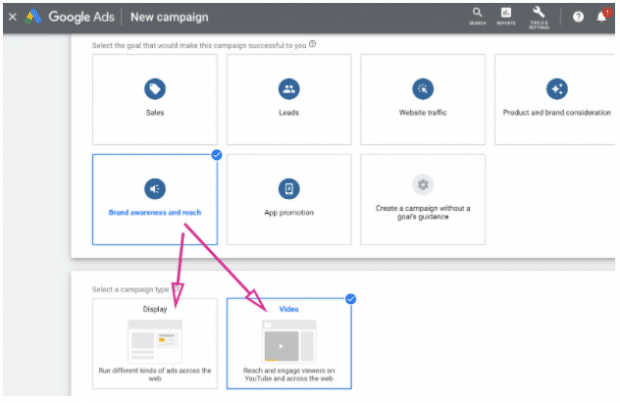
Note: Display ads can also be surfaced on YouTube, but remember that they aren’t videos, they’re just text and a thumbnail, and they also show up across Google’s Display network.
c) Since you’re most likely working with video, you’ll want to select your video campaign subtype:
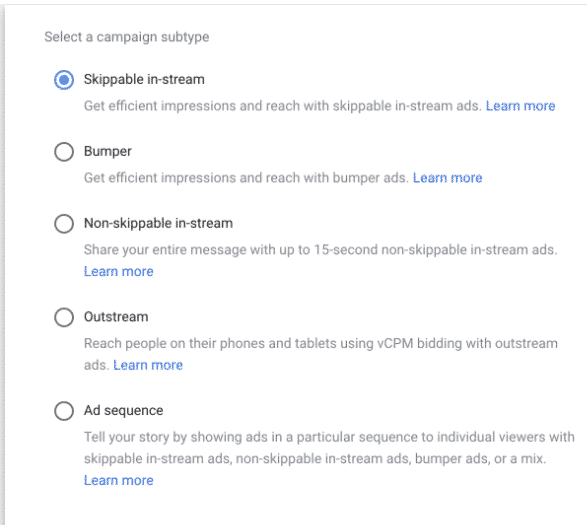
d) Don’t forget to name your campaign in a way that allows you to easily locate, manage, and optimize it in the future.
2. Define your campaign parameters
a) Select your bid strategy (for the most part, your campaign type will determine this: do you want conversions, clicks, or impressions?)
b) Enter your budget by day or as the total amount you’re willing to spend on the campaign. Also enter the dates your ad will run.
c) Select where your ads will show up:
- Discovery only (i.e., YouTube search results);
- All of YouTube (i.e., search results, but also channel pages, videos and the youTube homepage)
- YouTube Display network (i.e., non-YouTube affiliate websites, etc.)
d) Select your audience’s language, and location. You can choose to show ads worldwide, or target by country. Remember that only 15% of traffic to YouTube comes from the U.S., so it’s good to think broadly.
e) Choose how “sensitive” your brand safety guidelines are. In other words: how much profanity, violence or sexually suggestive content are you willing to have your ads run alongside? More sensitive brands will have their ads running in a smaller pool of videos, which may drive up the price you pay.
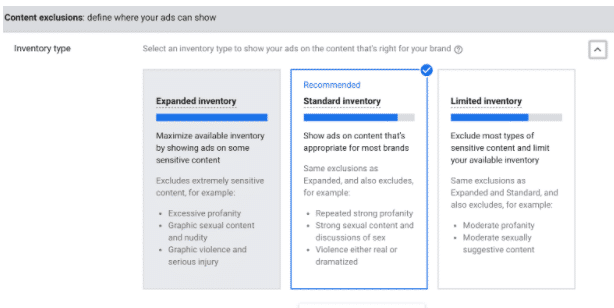
3. Target your audience
If you haven’t created buyer personas yet, take the time to do so. The more you know about your audience, the better you can target them, and the higher your ROI.
- Demographics: This covers age, gender, parental status, and household income. But YouTube also offers more detailed life-stage data: you can target new homeowners, college students, new parents, for instance.
- Interests: Use topics and keywords to target people based on their past behaviour (i.e., search topics). This is how YouTube helps you find people at crucial moments, like when they’re researching their next electronics purchase, or trying to learn how to build a website.
- Remarketing: Target audiences who have already interacted with your other videos, your website or your app.
4. Set your campaign to live
a) Enter the link to your ad, and hit the Create Campaign button to set your campaign running.
For more nitty-gritty detail, YouTube has their own guidelines for ad creation here.
Pro Tip: This is also the place to go if you want to get ambitious and start experimenting with ad sequence campaigns, where you can upload multiple types of ads that support each other and are arranged to surface to your audience in the right order.
YouTube ad specs
Skippable and non-skippable in-stream video ads on YouTube must first be uploaded as regular YouTube videos. So, for the most part your video ad’s technical specs (file size, ad dimensions, ad image sizes, et cetera) will be the same as for any YouTube video. Once it’s uploaded to your channel, you’re ready to go.
The exception here is Discovery ads, which must conform to the following:
YouTube ad specs (for Discovery ads)
- File format: AVI, ASF, Quicktime, Windows Media, MP4 or MPEG
- Video Codec: H.264, MPEG-2 or MPEG-4
- Audio Codec: AAC-LC or MP3
- Aspect ratio: 16:9 or 4:3 is recommended, but YouTube will automatically adapt the file depending on the aspect ratio and device
- Frame rate: 30 FPS
- Maximum file size: 1 GB for Discovery ads
YouTube video ad length guidelines
Minimum length
- Skippable ads: 12 seconds
Maximum length
- Skippable ads: 3 minutes
- Skippable ads on YouTube Kids: 60 seconds
- Non-skippable ads: 15 seconds
- Non-skippable ads in EMEA, Mexico, India, Malaysia and Singapore: 20 seconds
- Bumper ads: 6 seconds
YouTube advertising best practices
YouTube’s advertising engine is powerful and capable of endless optimization tweaks, but at the end of the day, your ad’s success will depend on how it connects with people. That means your creative choices matter. Here are our best tips for effective video ads on YouTube.
Hook people immediately
What’s a hook? Maybe it’s a familiar face. A strong mood or emotion. Tight framing of key products or faces (unfamiliar ones, too). Perhaps a surprising or unusual genre choice like humour or suspense. Or a catchy song, if you can secure the rights.
For instance, this leaderboard-topping Vrbo ad starts off powerfully because of its opening shot of outright misery. Paired with a dissonant title (“Sunny beaches, sandy beaches,” etc.), audiences have a little bit of tension to keep them interested. Why is the sunny beach video about a sad wet man?
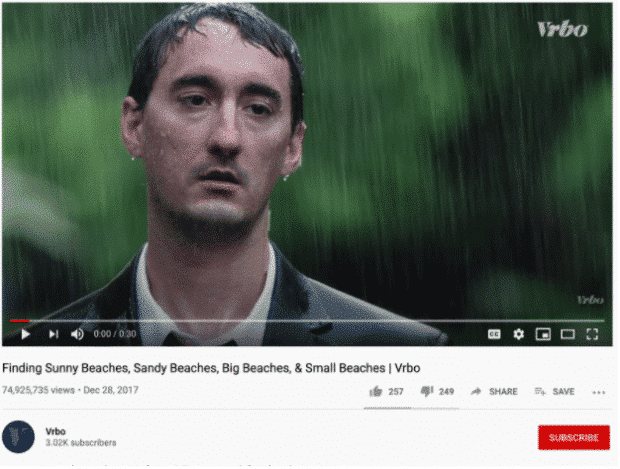
Source: VRBO
If you watch the video you’ll quickly realize the opening shot has little to do with the rest of the ad: it’s a bit of a bait and switch, but it’s jaunty enough that it works.
Brand early, but brand meaningfully
According to YouTube, top-of-funnel awareness ads perform best when branding appears in the first five seconds and throughout the ad. Meanwhile, ads aimed for audiences further down the funnel, (eg., consideration-phase viewers) might want to brand later to allow viewers to engage with the ad’s story, and drive higher watch times.
For a refreshing example of how a brand can fully embody its positioning, take a look at Mint Mobile’s new #stayathome-inflected ad. In it, majority owner and famously handsome man Ryan Reynolds alludes to the expensive studio-shot video Mint Mobile had started to prepare. Instead, he screenshares a Powerpoint with a bar graph and some “next steps.”
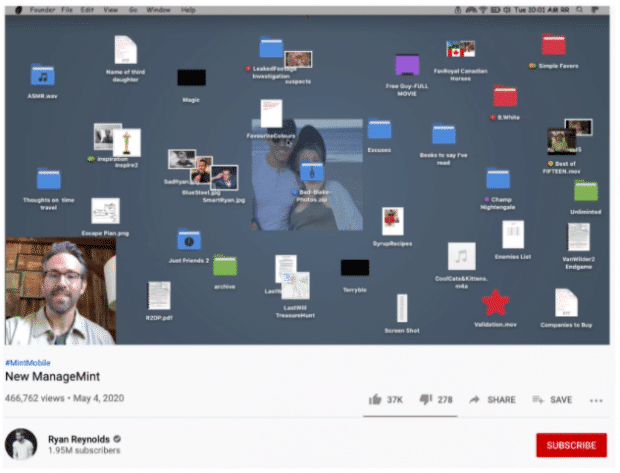

Source: Mint Mobile
The takeaway here? Branding is more than just making sure your logo shows up in the first 5 seconds, per YouTube’s recommendations. A truly great video ad personifies your brand in a way where literally every detail supports that character, tone and vision.
Connect with story + emotion
In 2018, Wells Fargo ran a brand awareness campaign on YouTube that directly acknowledged their recent history of spectacular customer abuse scandals. According to the bank’s VP of marketing, the campaign—meant to re-establish trust with regular people—was seen as risky and polarizing for internal stakeholders.
No matter your personal opinion of retail banking, in this one-minute long cornerstone ad, the combination of high-end costume-drama Western visuals and uplifting shots of people “doing the right thing” in offices is undeniably emotionally effective. Add in some famous guitar riffs and you have some pretty stirring stuff.
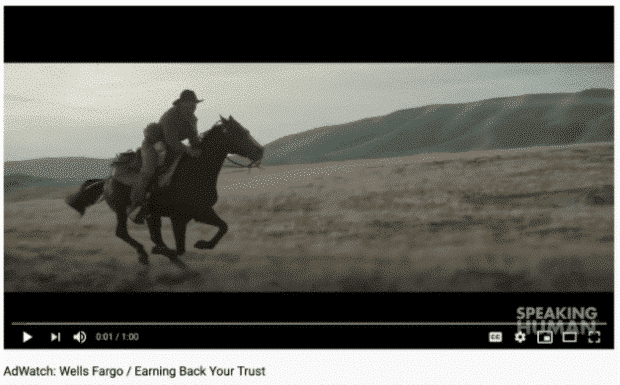
Source: Wells Fargo
The takeaway: anyone can “tell a story.” If you want to tell a really effective one, go for the throat and tell the story that takes a risk.
Pro Tip: And if you have the resources for multi-ad sequencing (i.e., multiple videos of differing lengths that target your audience in a given order), there are several kinds of narrative arc you might want to consider.
Show people what to do next
As we’ve mentioned, your YouTube ad needs a goal in order for you to measure its success.
If your campaign goals are lower-funnel actions (e.g., clicks , sales, conversions, or traffic) then consider setting the ad up as a TrueView for action campaign. This will give additional clickable elements to your ad, so viewers can click before the end.
For instance, Monday.com—who certainly have me targeted, anyway—have CTA overlays and companion banners galore.
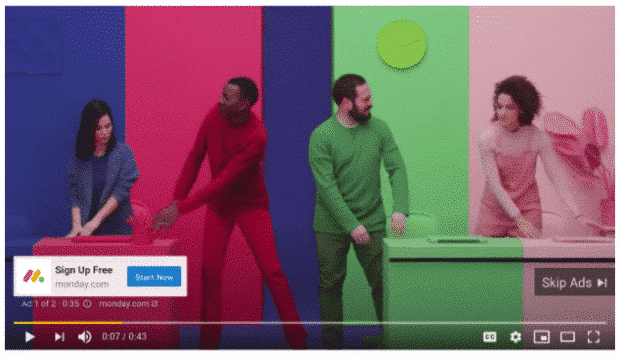
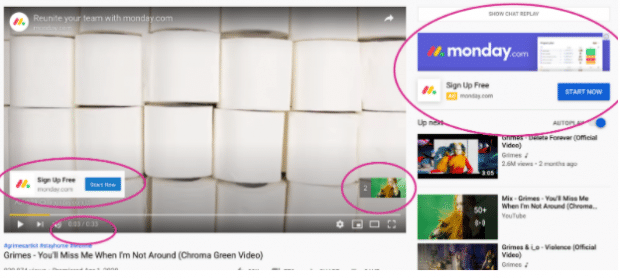
Don’t be afraid to use templates
Not every brand has a century-old-bank or unicorn-startup budget to blow. Grocery delivery service Imperfect, for instance, creates quick, simple, personable videos that are perfectly effective.
If you know what your message is, you don’t need a Hollywood A-lister to deliver it. Our social video strategy toolkit has more suggestions to get you moving on making your masterpiece.
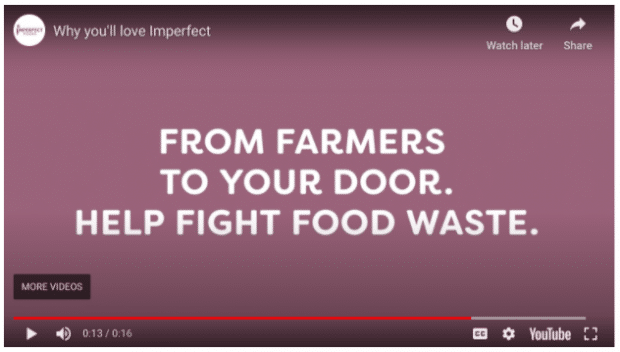
Source: Imperfect
Use Hootsuite to promote your YouTube channel and drive engagement. Easily publish videos to Facebook, Instagram and Twitter—all from one dashboard. Try it free today.
